If you want to walk on snow like you own the land, stop being ignorant. Because ignorance is always afraid of change. And you are not out in the cold to remain a diehard. Are you?
Trust me, snowshoeing isn’t about walking aimlessly on the snowy terrains, it requires prior planning and consideration. If you plan to roam the powdery snow without a goal, you are planning to be the next meal of wildlife lurking there anywhere. Well, at least ‘they’ have got a goal to achieve.
Let me state it more clearly, good planning means knowing the nitty-gritty as well as the itty-bitty details of your venture. Poor planning on the other hand paves roads for others, not for you.
Snowshoeing is a super fun activity that breeds clarity of mind, good physical health, happiness, determination, confidence, and much more that can help you build your power skills. So, let it remain a recreational activity by mastering it.
Since you have made up your mind about educating yourself on this fun snow sport, let’s dive into the well of information that I have prepared for you, and come out wise.
What Is Snowshoeing?
An extension of winter hiking? One can say. Often combined with trail running, mountaineering, and glacier hiking, snowshoeing is a hobby suitable for people of all ages.
Did I surprise you by mentioning that age doesn’t matter here as long as you are capable of ascending the mountain? You might be wondering how it is possible.
Let me answer, snowshoeing is a sport that lets you set your own goals and judge your skill level by yourself. You are judging your abilities and taking on new challenges all on your own.
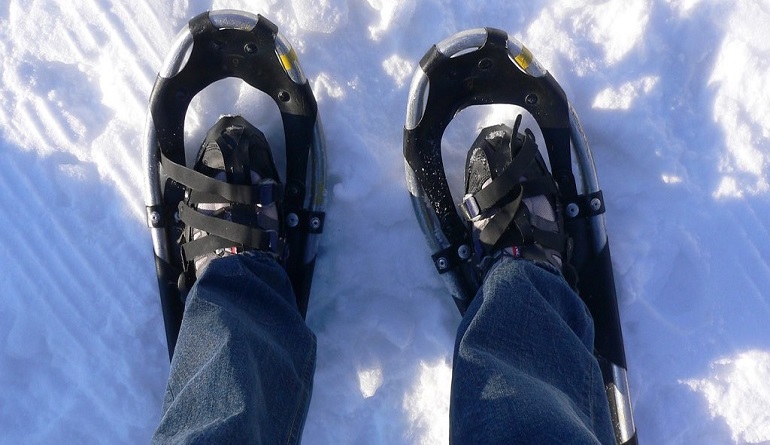
Some winter sports enthusiasts address snowshoeing as a sport that lies anywhere between skiing and snow hiking. It is a type of walking that demands assistance from special kinds of bindings and shoes, as such footwear helps in displacing weight over a larger area.
We call it floatation because while wearing snowshoes, you are kind of floating over the surface of the snow instead of sinking deep into it.
The design of the footwear depends on the type of terrain you choose to snowshoe on. Hard snow demands shoes with less surface area, while shoes with a large surface area are suitable for deep powder for better floatation.
Snowshoeing is a great activity if you don’t have a thing for ice skating or snowboarding or the weather conditions aren’t in your favor. It is also a great option if you are budget-oriented.
I mean, if the expense of skiing makes you want to avoid the snowy terrains, snowshoeing is the best substitute for having a great time on snow. The only equipment you will be needing includes snowshoes, poles, and proper attire for the purpose.
Besides inexpensiveness, snowshoeing also allows you to hit the snow without any prior experience. Yes! You just need a few basic skills to master snowshoeing.
As the name sounds, it involves putting on shoes and just going for a walk. However, you need to gather information regarding the terrain you choose to walk on for your snowshoe adventure.
What You Need to Go Snowshoeing
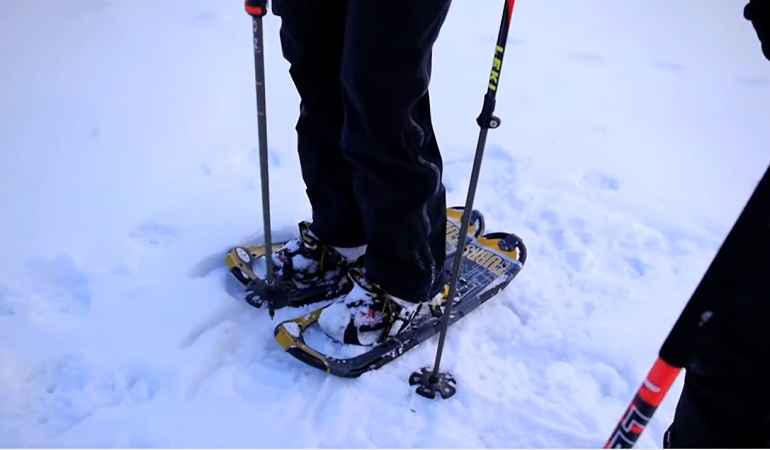
So, what do you need for this winter hiking? Let’s discuss this. To be able to walk on snow, you need some footwear, for that you have the following options:
- Crampons
- Snowshoes
- Hiking boots
- Skis
You need to choose any one from all four mentioned above. Each type has its advantages and all are designed for deep snow terrains. Always select what goes with your weight, the terrain, and the weather. If you are a beginner, I suggest you opt for snowshoes. Snowshoes are a friendlier version of crampons after all.
In the end, you are required to wear waterproof warm shoes. It can be any hiking boots or any traditional snowshoes as the bindings easily take in any type.
Besides wearing shoes, you need proper clothing layers for insulation, poles if you find them necessary as it also depends on your ability and the terrain, and all the other necessary accessories.
Here is a checklist if you are confused about what to take on your snowshoeing adventures, besides snowshoes:
Poles:
If you are having a hard time maintaining balance on snow just run and grab a pair of poles. It can be collapsible or regular ski poles.
Avalanche Transceiver:
You don’t know what is waiting for you on the white land, so always carry a beacon with you. It is a small device that transmits and receives signals. While on your venture, you might be faced with a gigantic avalanche. At that moment, you need to use a transceiver to locate people buried under the avalanche.
Layering:
Why it is important to wear layers? The temperature in the mountains is very unpredictable, hence, tends to fluctuate a lot. Before embarking on your journey, always check the avalanche forecast and snow conditions and plan accordingly.
The same goes for clothing. It is better to bring an extra clothing layer in case you get trapped in brutally cold weather.
For further inquiries, you can watch this video filmed on what to bring when going snowshoeing.
How to Dress for Snowshoeing
The rule is to dress in layers. Only one jacket or a sweater cannot cope with the deadly weather. It is a wise move to always dress up in layers for the unpredictable weather. This way, you can easily remove or add layers as per the need. However, layering up doesn’t implement overheating yourself by overdressing.
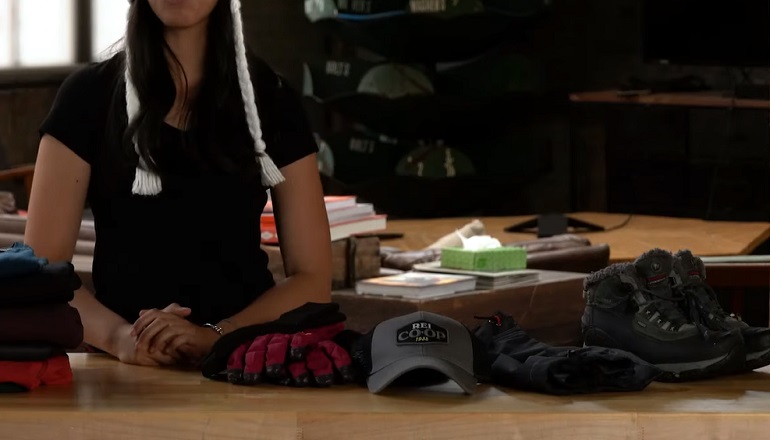
Let’s briefly discuss the layering system, so you get a better understanding of its significance:
Base layer
It sits closest to your body. As the name suggests, the base layer makes the base for all the layers. Being the first layer, it needs to be form-fitting and body-hugging.
This layer should be able to keep you warm in the cold and even if you sweat. One of its main functions is to wick your sweat away. So, another rule is to avoid cotton material layers.
If you are sweating and wearing a cotton base, forget about staying warm. This is because cotton fiber tends to get wet fast but dries out late. It is wise to opt for any synthetic materials like polyester, merino wool, or bamboo fibers.
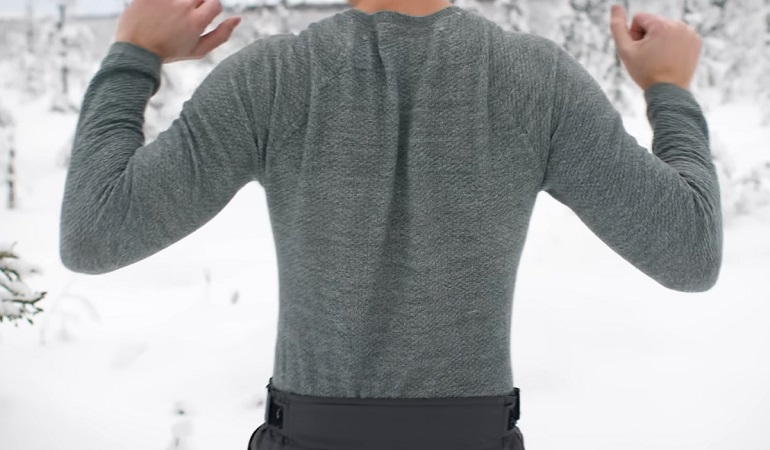
Base layers are offered in different weights. It is you to decide the thickness according to the weather forecast. The heaviest layer tends to provide warmth the most. However, medium thickness proves ideal for many situations.
Mid layer
The middle layer acts like an insulator to provide necessary warmth to the wearer. It rests between your base layer and outer shell.
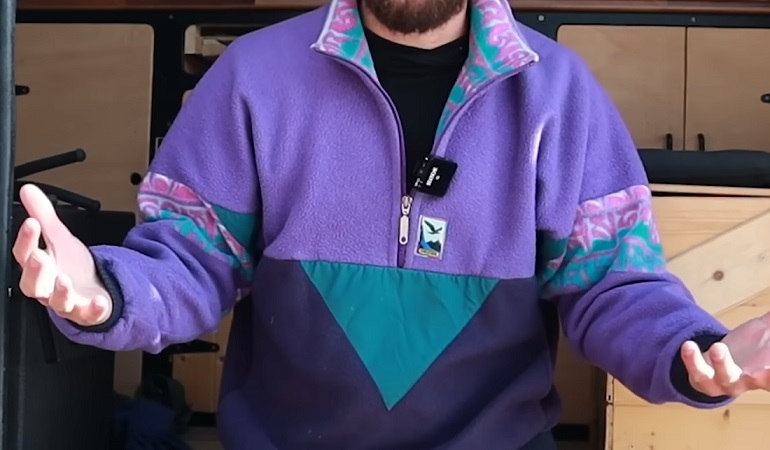
Being an insulator, the middle layer should be able to trap air inside for better insulation. The trapped warm air, in return, eliminates the chilly feeling. Ideal materials for the mid-layer are polyester and fleece-made insulated ski pants and jackets.
Besides insulation, also check for its mobility. A too-tight middle layer can lead to immobility which is not an ideal case.
Outer layer
The outer layer is your first line of defense. It should be water-repellent and windproof, along with the qualities of an insulating layer. This layer actually acts as a hard shell against snow, moisture, wind, and scrapping and rubbing.
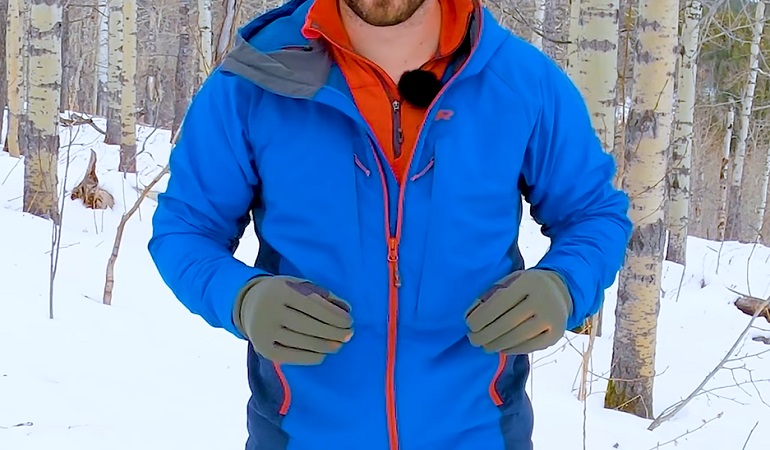
However, the outer shell must be breathable, and the design should also be adaptive. I mean, you surely don’t want to die of excess warmth, so always look for a jacket with zippers and vents.
Hat and gloves/mittens
Cover your extremities well enough! You need to figure out your vulnerable body parts and cover them with extra care. Your hands are mostly doing the work while snowshoeing, so tend to them seriously.
One can wear mittens or gloves however they like. but remember both have their pros and cons. Mittens tend to be warmer but limit the dexterity of your hands. On the flip side, gloves allow easy mobility but tend to be less warm than mittens.
Whatever you choose, the material should be fleece, Gore-tex, or other waterproof and insulating material. One can also put together wool liners and separate shells and make a deadly combo. Besides gloves, do consider wearing a balaclava or a headband for extra warmth.
Sunglasses
Eye protection provides another line of defense against the sun. As we discussed, in winter the weather is unpredictable, so always prepare accordingly.
I mean, there might be clouds, but you are not sure what comes next. Always carry sunglasses to mitigate ultraviolet exposure. Also, snow tends to reflect sunlight. It can get worse for you.
Suitable Boots and Socks
Anti-cotton rule applies here too. While choosing the best stockings for you, always opt for synthetic or wool material.
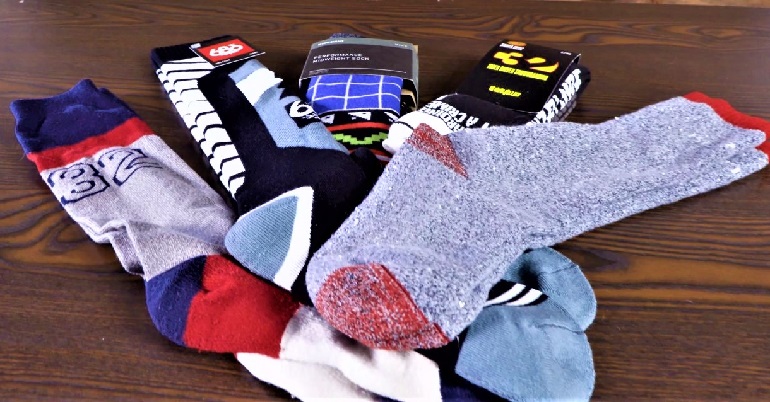
As far as footwear is concerned, your regular shoes would work as long as they are waterproof. Even if they aren’t, you can apply water-repellent sprays or waxes to make them perform in the desired manner.
Where to Go Snowshoeing
How to know where to land? The answer is, through guides or tour classes. Signing up for a snowshoe class will save you a lot of leg work regarding suitable locations. Similarly, guidebooks can also offer inspiration for snowshoe spots.
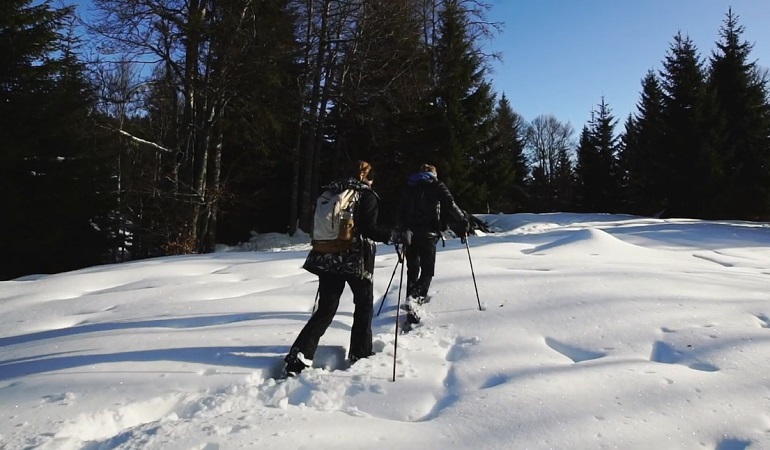
If you are not so confident in your snowshoe skills because you haven’t been snowshoeing, enrolling yourself in a tour class is a must. This way, you not only learn the basics but also prep yourself for avalanche danger. Furthermore, these classes also enlighten you regarding the types of terrains.
If you don’t feel like joining a class, you can always resort to joining walkers on cross-country ski resorts. Mountain lodges and resorts with this facility allow you to follow their snowshoeing trails for a fee and let you learn the basics. If you are not into cross-country trails, you can also snowshoe in any recreational park.
However, if you have learned a thing or two about this sport and you are confident then any hiking area can do. You just need to gather information regarding the area for safety or you can just go to your summer hiking spot. Besides that, State or National forests are also an option.
Tips for Choosing the Right Snowshoes
Before you buy a new snowshoe pair, make sure you answer the following two questions. Believe me, when I say, it is more complicated than just finding a perfect snowshoe size, as these shoes are very much dependent on your body weight and height.
What is your terrain type? Is it flat? Is the ice hard? What are the snowy conditions in that area? Answering this question will let you choose from flat, rolling, or mountain terrain shoes. Your destiny determines the type you need. Refer to the table given below for further clarity.
| Flat Terrain | Rolling Terrain | Steep Terrain | |
|---|---|---|---|
| Bindings | Fixed bindings, simple | Floating bindings for easy mobility | Rotating bindings |
| Crampon | Modest | Moderate | Aggressive |
| Heel lift | None | Moderate | Highest |
Flat Terrain Snowshoes:
These shoes are designed for very casual use and so come at a cheaper cost. It features a simple binding system and offers modest traction. It usually lacks the heel lift feature.
Rolling Terrain Snowshoes:
These shoes work well on flat as well as moderately sloped terrains. You need adjustable bindings on rolling terrains as you would be switching between uphill and downhill a lot.
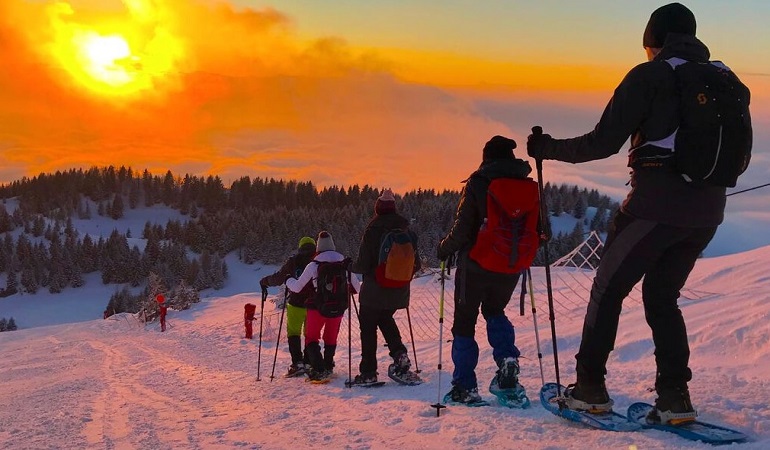
Mountain terrain snowshoes:
These are quite expensive and boast an aggressive crampon system. Such type works well on icy terrains and on moderate to steep slopes.
How much do you and your gear weigh? What is the approximate value? You need to estimate the overall weight you are going to put on your shoes. For instance, your body weight and the weight of your backpack.
One more thing, being the first timer, you should also consider renting your gear besides buying a new one. Doing so allows you to test if you like or dislike the sport.
I mean, what’s the point of wasting your hard-earned money when you have the facility of a test trial? The rental stores let you try different pairs and decide according to the questions mentioned above. I suggest you rent out flat terrain snowshoes on your initial days.
How to Snowshoe: Basic Techniques
You know what, you don’t always have to find established trails to snowshoe, as you can snowshoe off trail also. There are many ways of snowshoeing on the snow, read on to find the terrain of your taste:
How to Snowshoe on Flat Terrain
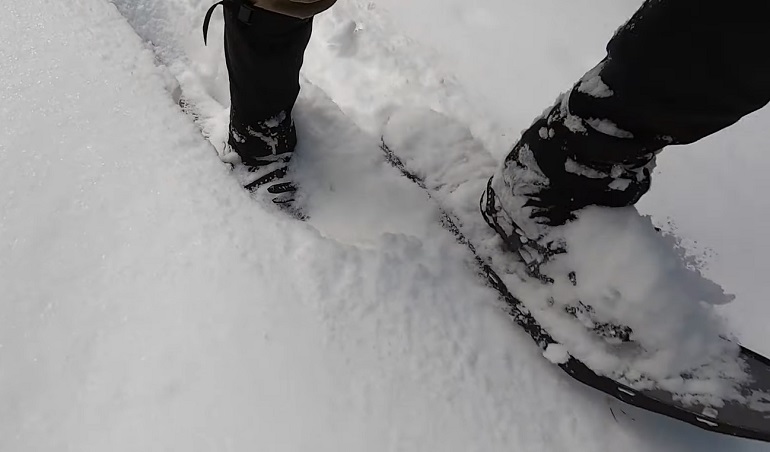
Although walking on flat terrain is pretty intuitive, you need to set a specific stance for walking on flat or rolling terrain. You surely don’t want to step on the inside of the binding frame and fall.
So, always keep an appropriate distance between your feet and stroll cautiously. Walking in this manner always results in aching hips and groin on your initial walks only.
You need simple bindings that demand tightening only once at the beginning. These fixed bindings/shoes are fixed to the entire length of your feet to avoid them from sliding out.
How to Snowshoe Uphill
To ascend uphill, you require rotating or floating bindings. These bindings are a technical type that allows easy adjustability when you switch from walking steep ascents to descending downhill. These snowshoes also feature a slight heel lift to assist you in moving forward.
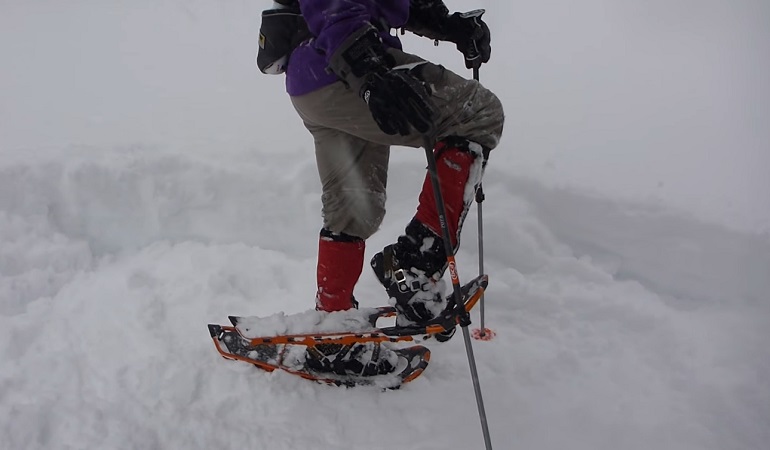
Here, you need to apply the kick-step technique. Lift your foot and kick into the snow, this way your toe will pave way for your snowshoe. You might need to kick two or more times to clear the surface for you to stand on.
Let’s talk about your stance now. Your feet will be angled according to the slope, with your back hanging behind and your toes ahead. This way, it gets easier to plant snowshoe cleats into the powder. However, if you end up digging a big hole in the snow while kicking, opt for another route.
Just so you know, the kick-step technique is only applicable to deep powder. For hard snow, the snow poles and cleats of your shoes will be guiding you instead.
How to Snowshoe Downhill
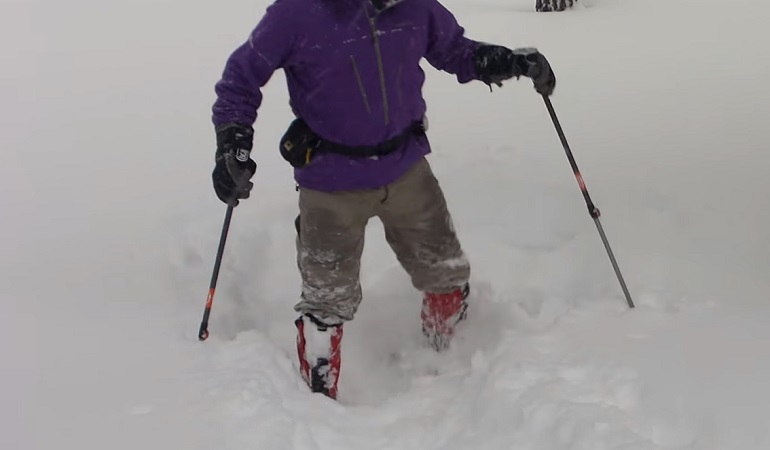
The right stance is very important on descents. You don’t want to go rolling down the peak, right? First thing first, you need to walk slowly and smoothly. Next, always keep your poles planted in front of you to get that extra support.
Remember, you are leaning down, so get the best use of poles and use them as a pillar for support. Also, always keep your lower limbs relaxed and knees bent. Lastly, while walking, always put your heel first and try to grab hold of the surface.
Now that we are done with the important snowshoeing tips for the downhill journey, let’s discuss some crucial don’ts also.
- Do not ever risk rotating your toes (if not necessary) while going downhill.
- If you happen to slip, sit down immediately.
- Adjust your poles in safer spots before relying on them.
- Do not overswing your shoes.
How to Use Snowshoe Poles
Many snowshoers go without poles, however, many find them a necessary accessory. No doubt, trekking poles offer bags of balance and support.
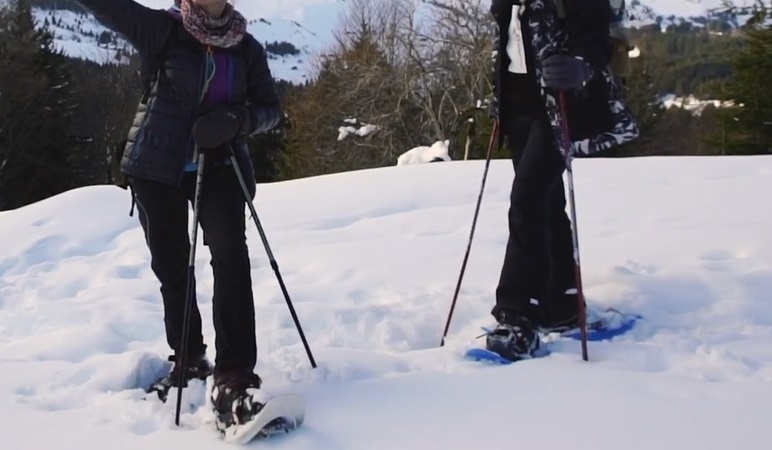
Mainly there are two types of poles you will find on market – adjustable poles and fixed-length poles. I suggest you go with adjustable poles while snowshoeing downhill. These snowshoe poles are the best choice as you can easily adjust their length of them.
While ascending uphill, you can shorten the length, on the other hand when going downhill you can easily maximize the length.
Watch this video If you are still confused about how to snowshoe.
Conclusion
Although snowshoeing is an easy winter sport, you need to prepare yourself a bit, just like you do for any other sport. One just cannot strap into snowshoes and conquer any terrain without any prior preparation. Steep slopes might get the best of beginners especially.
Besides learning the basics, you also need to train yourself on how to decipher avalanche forecasts for avalanche safety. So, while deciding where to go for snowshoeing, do not answer ‘go where the snow is.’
Hire a guide or take snowshoe tour classes for a safe journey. God knows a guide might take you to a more interesting route that you don’t know of.
As a beginner, you should avoid any avalanche-prone areas, hard-packed snow destinations, and steeper slopes. Instead, try any established trail in a resort or a park, and don’t forget to avoid ski tracks. Crashing into someone is the last thing you want.
0 Comments